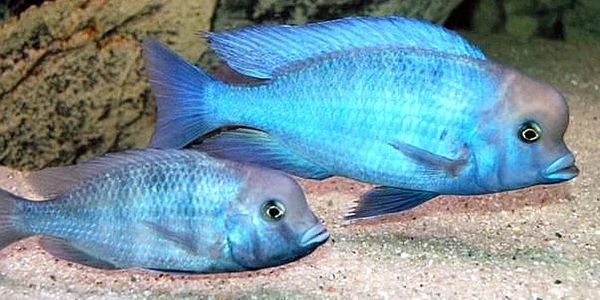
Size
Males frequently reach heights of at least 10 inches (25 centimeters). Usually, women stop growing after 8 inches (20cm).
Physical Characteristics and Behavior
With a gorgeous blue color throughout and various amounts of black patterns depending on the origin. It has a short, elongated body, a protruding hump on top of its skull as it ages, a long snout, and all of these features. This exhibition specimen’s gorgeous color and distinctive form make it the perfect choice for a large cichlid tank. As this cichlid ages, both sexes develop a noticeable hump on their skulls. A cranial hump is present in the front of its body, above and above its cute nose.
Habitat
Their daily lives are characterized by the following circumstances: The water should be between 72.0 and 82.0 degrees Fahrenheit (22.8 and 27.8 degrees Celsius), its pH should be between 7.2 and 8.8, and its hardness should be between 10 and 18 degrees relative to hydrogen carbonate. The light intensity should be moderate to high.
As Pet

- Care of Aquarium
Poor water quality will damage this species’ eyes and will cause all Malawi cichlids to degenerate. Depending on the bio load, perform 10% to 20% water changes per week, and occasionally vacuum the substrate.
Weekly water changes of between 10% and 20% are advised, depending on the bioload.
- Setup of an Aquarium
Lake Malawi receives its water from streams that are rich in minerals. Alkaline water that is heavily mineralized is the result of this combined with evaporation. In terms of pH and other water chemistries, Lake Malawi is renowned for its transparency and stability. It is simple to understand why it is crucial to keep an eye on tank parameters when using any Lake Malawi fish.
It is advised to use a minimum of 75 gallons of 5 feet in length. They can survive in freshwater or brackish freshwater, but they require strong and effective filtration as well as good water movement. Their eyes will be ruined by bad water quality. They will feel most comfortable on a sand-based surface. You can use freshwater or saltwater fish sand, although saltwater sand can help maintain a high pH. In addition to raising the water’s carbonate hardness, crushed coral or aragonite sand tends to dissolve more readily than salts. Maintaining a pH above neutral is crucial, but regular water changes are necessary for these fish since a higher pH makes ammonia more harmful.
- 75 gal. minimum tank size (284 L)
- Appropriate for Nano Tank: No
- Sand as a Substrate Type
- Moderate to moderate illumination is required.
- Temperature: 22.8 to 27.8 °C or 73 to 82.0 °F
- pH range: 7.2 to 8.8
- Range of Hardness: 10 to 18 dGH
- Brackish: Salt is not always present in their native environment, but they do have a modest tolerance; keep levels below 10% and less than 1.0002 in terms of specific gravity.
- Moving Water: All Moderate
- Water Regions: These fish can be found swimming throughout the tank.
Table





